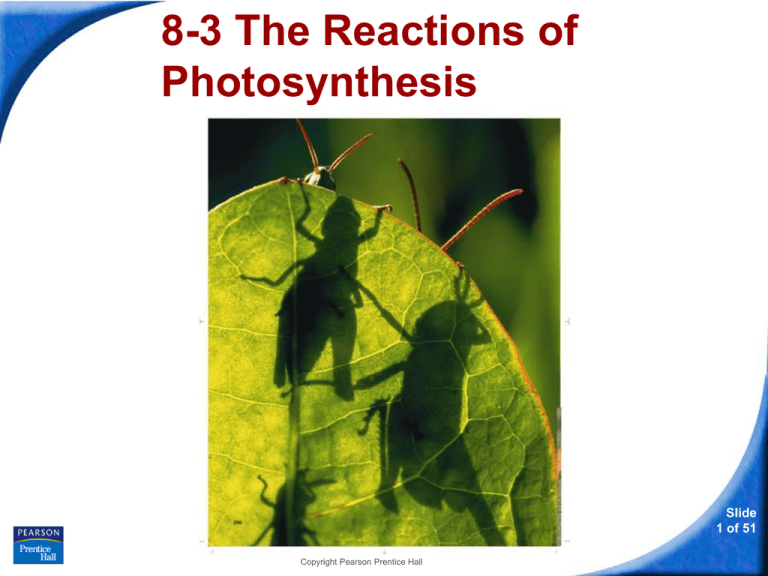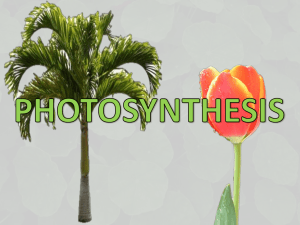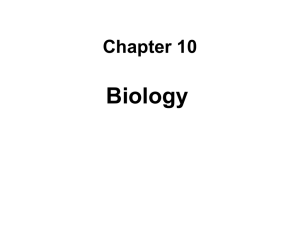
8-3 The Reactions of
Photosynthesis
Slide
1 of 51
Copyright Pearson Prentice Hall
8-3 The Reactions of Photosynthesis
Inside a Chloroplast
Inside a Chloroplast
In plants, photosynthesis takes place inside
chloroplasts.
Plant
Chloroplast
Plant cells
Slide
2 of 51
Copyright Pearson Prentice Hall
8-3 The Reactions of Photosynthesis
Inside a Chloroplast
Chloroplasts contain thylakoids—saclike
photosynthetic membranes.
Single
thylakoid
Chloroplast
Copyright Pearson Prentice Hall
Slide
3 of 51
8-3 The Reactions of Photosynthesis
Inside a Chloroplast
Thylakoids are arranged in stacks known as grana.
A singular stack is called a granum.
Granum
Chloroplast
Copyright Pearson Prentice Hall
Slide
4 of 51
8-3 The Reactions of Photosynthesis
Inside a Chloroplast
Proteins in the thylakoid membrane organize
chlorophyll and other pigments into clusters called
photosystems, which are the light-collecting units
of the chloroplast.
Photosystems
Chloroplast
Copyright Pearson Prentice Hall
Slide
5 of 51
8-3 The Reactions of Photosynthesis
Inside a Chloroplast
The reactions of photosystems include: the lightdependent reactions and the light-independent
reactions, or Calvin cycle.
The light-dependent reactions take place within the
thylakoid membranes.
The Calvin cycle takes place in the stroma, which
is the region outside the thylakoid membranes.
Slide
6 of 51
Copyright Pearson Prentice Hall
8-3 The Reactions of Photosynthesis
H2O
Inside a Chloroplast
CO2
Light
NADP+
ADP + P
Lightdependent
reactions
Calvin
Calvin
cycle
Cycle
Chloroplast
Sugars
O2
Slide
7 of 51
Copyright Pearson Prentice Hall
8-3 The Reactions of Photosynthesis
Electron Carriers
Electron Carriers
When electrons in chlorophyll absorb sunlight, the
electrons gain a great deal of energy.
Cells use electron carriers to transport these highenergy electrons from chlorophyll to other
molecules.
Slide
8 of 51
Copyright Pearson Prentice Hall
8-3 The Reactions of Photosynthesis
Electron Carriers
One carrier molecule is NADP+.
Electron carriers, such as NADP+, transport
electrons.
NADP+ accepts and holds 2 high-energy electrons
along with a hydrogen ion (H+). This converts the
NADP+ into NADPH.
Slide
9 of 51
Copyright Pearson Prentice Hall
8-3 The Reactions of Photosynthesis
Electron Carriers
The conversion of NADP+ into NADPH is one way
some of the energy of sunlight can be trapped in
chemical form.
The NADPH carries high-energy electrons to
chemical reactions elsewhere in the cell.
These high-energy electrons are used to help build
a variety of molecules the cell needs, including
carbohydrates like glucose.
Slide
10 of 51
Copyright Pearson Prentice Hall
8-3 The Reactions of Photosynthesis
Light-Dependent
Reactions
What happens in the light-dependent
reactions?
Slide
11 of 51
Copyright Pearson Prentice Hall
8-3 The Reactions of Photosynthesis
Light-Dependent
Reactions
Light-Dependent Reactions
The light-dependent reactions require light.
The light-dependent reactions produce
oxygen gas and convert ADP and NADP+
into the energy carriers ATP and NADPH.
Slide
12 of 51
Copyright Pearson Prentice Hall
8-3 The Reactions of Photosynthesis
Light-Dependent
Reactions
Slide
13 of 51
Copyright Pearson Prentice Hall
8-3 The Reactions of Photosynthesis
Light-Dependent
Reactions
Photosynthesis begins when pigments in
photosystem II absorb light, increasing their
energy level.
Photosystem II
Slide
14 of 51
Copyright Pearson Prentice Hall
8-3 The Reactions of Photosynthesis
Light-Dependent
Reactions
These high-energy electrons are passed on to the
electron transport chain.
Photosystem II
High-energy
electron
Electron
carriers
Copyright Pearson Prentice Hall
Slide
15 of 51
8-3 The Reactions of Photosynthesis
Light-Dependent
Reactions
Enzymes on the thylakoid membrane break water
molecules into:
Photosystem II
2H2O
High-energy
electron
Electron
carriers
Copyright Pearson Prentice Hall
Slide
16 of 51
8-3 The Reactions of Photosynthesis
• hydrogen ions
• oxygen atoms
• energized electrons
Light-Dependent
Reactions
Photosystem II
+
O2
2H2O
High-energy
electron
Electron
carriers
Copyright Pearson Prentice Hall
Slide
17 of 51
8-3 The Reactions of Photosynthesis
Light-Dependent
Reactions
The energized electrons from water replace the
high-energy electrons that chlorophyll lost to the
electron transport chain.
Photosystem II
+
O2
2H2O
Slide
18 of 51
High-energy
electron
Copyright Pearson Prentice Hall
8-3 The Reactions of Photosynthesis
Light-Dependent
Reactions
As plants remove electrons from water, oxygen is
left behind and is released into the air.
Photosystem II
+
O2
2H2O
Slide
19 of 51
High-energy
electron
Copyright Pearson Prentice Hall
8-3 The Reactions of Photosynthesis
Light-Dependent
Reactions
The hydrogen ions left behind when water is
broken apart are released inside the thylakoid
membrane.
Photosystem II
+
O2
2H2O
Slide
20 of 51
High-energy
electron
Copyright Pearson Prentice Hall
8-3 The Reactions of Photosynthesis
Light-Dependent
Reactions
Energy from the electrons is used to transport H+
ions from the stroma into the inner thylakoid
space.
Photosystem II
+
O2
2H2O
Slide
21 of 51
Copyright Pearson Prentice Hall
8-3 The Reactions of Photosynthesis
Light-Dependent
Reactions
High-energy electrons move through the electron
transport chain from photosystem II to
photosystem I.
Photosystem II
+
O2
2H2O
Photosystem I
Copyright Pearson Prentice Hall
Slide
22 of 51
8-3 The Reactions of Photosynthesis
Light-Dependent
Reactions
Pigments in photosystem I use energy from
light to re-energize the electrons.
+
O2
2H2O
Photosystem I
Copyright Pearson Prentice Hall
Slide
23 of 51
8-3 The Reactions of Photosynthesis
Light-Dependent
Reactions
NADP+ then picks up these high-energy
electrons, along with H+ ions, and becomes
NADPH.
+
O2
2H2O
2 NADP+
2
2
Copyright Pearson Prentice Hall
NADPH
Slide
24 of 51
8-3 The Reactions of Photosynthesis
Light-Dependent
Reactions
As electrons are passed from chlorophyll to
NADP+, more H+ ions are pumped across the
membrane.
+
O2
2H2O
2 NADP+
2
2
Copyright Pearson Prentice Hall
NADPH
Slide
25 of 51
8-3 The Reactions of Photosynthesis
Light-Dependent
Reactions
Soon, the inside of the membrane fills up with
positively charged hydrogen ions, which makes
the outside of the membrane negatively charged.
+
O2
2H2O
2 NADP+
2
2
Copyright Pearson Prentice Hall
NADPH
Slide
26 of 51
8-3 The Reactions of Photosynthesis
Light-Dependent
Reactions
The difference in charges across the membrane
provides the energy to make ATP.
+
O2
2H2O
2 NADP+
2
2
Copyright Pearson Prentice Hall
NADPH
Slide
27 of 51
8-3 The Reactions of Photosynthesis
Light-Dependent
Reactions
H+ ions cannot cross the membrane directly.
ATP synthase
+
O2
2H2O
2 NADP+
2
2
Copyright Pearson Prentice Hall
NADPH
Slide
28 of 51
8-3 The Reactions of Photosynthesis
Light-Dependent
Reactions
The cell membrane contains a protein called ATP
synthase that allows H+ ions to pass through it.
ATP synthase
+
O2
2H2O
2 NADP+
2
2
Copyright Pearson Prentice Hall
NADPH
Slide
29 of 51
8-3 The Reactions of Photosynthesis
Light-Dependent
Reactions
As H+ ions pass through ATP synthase, the
protein rotates.
ATP synthase
+
O2
2H2O
2 NADP+
2
2
Copyright Pearson Prentice Hall
NADPH
Slide
30 of 51
8-3 The Reactions of Photosynthesis
Light-Dependent
Reactions
As it rotates, ATP synthase binds ADP and a
phosphate group together to produce ATP.
ATP synthase
+
O2
2H2O
ADP
2 NADP+
2
2
Copyright Pearson Prentice Hall
NADPH
Slide
31 of 51
8-3 The Reactions of Photosynthesis
Light-Dependent
Reactions
Because of this system, light-dependent electron
transport produces not only high-energy electrons
but ATP as well.
ATP synthase
+
O2
2H2O
ADP
2 NADP+
2
2
Copyright Pearson Prentice Hall
NADPH
Slide
32 of 51
8-3 The Reactions of Photosynthesis
Light-Dependent
Reactions
The light-dependent reactions use water, ADP, and
NADP+.
The light-dependent reactions produce oxygen, ATP,
and NADPH.
These compounds provide the energy to build
energy-containing sugars from low-energy
compounds.
Slide
33 of 51
Copyright Pearson Prentice Hall
8-3 The Reactions of Photosynthesis
The Calvin Cycle
What is the Calvin cycle?
Slide
34 of 51
Copyright Pearson Prentice Hall
8-3 The Reactions of Photosynthesis
The Calvin Cycle
The Calvin Cycle
ATP and NADPH formed by the light-dependent
reactions contain an abundance of chemical
energy, but they are not stable enough to store
that energy for more than a few minutes.
During the Calvin cycle plants use the energy that
ATP and NADPH contain to build high-energy
compounds that can be stored for a long time.
Slide
35 of 51
Copyright Pearson Prentice Hall
8-3 The Reactions of Photosynthesis
The Calvin Cycle
The Calvin cycle uses ATP and NADPH
from the light-dependent reactions to
produce high-energy sugars.
Because the Calvin cycle does not require
light, these reactions are also called the
light-independent reactions.
Slide
36 of 51
Copyright Pearson Prentice Hall
8-3 The Reactions of Photosynthesis
The Calvin Cycle
Six carbon dioxide molecules enter the cycle from
the atmosphere and combine with six 5-carbon
molecules.
CO2 Enters the Cycle
Slide
37 of 51
Copyright Pearson Prentice Hall
8-3 The Reactions of Photosynthesis
The Calvin Cycle
The result is twelve 3-carbon molecules, which
are then converted into higher-energy forms.
Slide
38 of 51
Copyright Pearson Prentice Hall
8-3 The Reactions of Photosynthesis
The Calvin Cycle
The energy for this conversion comes from ATP
and high-energy electrons from NADPH.
Energy Input
12
12 ADP
12 NADPH
12 NADP+
Slide
39 of 51
Copyright Pearson Prentice Hall
8-3 The Reactions of Photosynthesis
The Calvin Cycle
Two of twelve 3-carbon molecules are removed
from the cycle.
Energy Input
12
12 ADP
12 NADPH
12 NADP+
Slide
40 of 51
Copyright Pearson Prentice Hall
8-3 The Reactions of Photosynthesis
The Calvin Cycle
The molecules are used to produce sugars, lipids,
amino acids and other compounds.
12
12 ADP
12 NADPH
12 NADP+
6-Carbon sugar
produced
Slide
41 of 51
Copyright Pearson Prentice Hall
Sugars
and other compounds
8-3 The Reactions of Photosynthesis
The Calvin Cycle
The 10 remaining 3-carbon molecules are
converted back into six 5-carbon molecules,
which are used to begin the next cycle.
12
12 ADP
6 ADP
12 NADPH
6
12 NADP+
5-Carbon Molecules
Regenerated
Slide
42 of 51
Copyright Pearson Prentice Hall
Sugars
and other compounds
8-3 The Reactions of Photosynthesis
The Calvin Cycle
The two sets of photosynthetic reactions work
together.
• The light-dependent reactions trap sunlight
energy in chemical form.
• The light-independent reactions use that
chemical energy to produce stable, highenergy sugars from carbon dioxide and water.
Slide
43 of 51
Copyright Pearson Prentice Hall
8-3 The Reactions of Photosynthesis
Factors Affecting
Photosynthesis
Factors Affecting Photosynthesis
Many factors affect the rate of photosynthesis,
including:
• Water
• Temperature
• Intensity of light
Slide
44 of 51
Copyright Pearson Prentice Hall
8-3
Click to Launch:
Continue to:
- or -
Slide
45 of 51
Copyright Pearson Prentice Hall
8-3
In plants, photosynthesis takes place inside the
a. thylakoids.
b. chloroplasts.
c. photosystems.
d. chlorophyll.
Slide
46 of 51
Copyright Pearson Prentice Hall
8-3
Energy to make ATP in the chloroplast comes
most directly from
a. hydrogen ions flowing through an enzyme in
the thylakoid membrane.
b. transfer of a phosphate from ADP.
c. electrons moving through the electron
transport chain.
d. electrons transferred directly from NADPH.
Slide
47 of 51
Copyright Pearson Prentice Hall
8-3
NADPH is produced in light-dependent reactions
and carries energy in the form of
a. ATP.
b. high-energy electrons.
c. low-energy electrons.
d. ADP.
Slide
48 of 51
Copyright Pearson Prentice Hall
8-3
What is another name for the Calvin cycle?
a. light-dependent reactions
b. light-independent reactions
c. electron transport chain
d. photosynthesis
Slide
49 of 51
Copyright Pearson Prentice Hall
8-3
Which of the following factors does NOT directly
affect photosynthesis?
a. wind
b. water supply
c. temperature
d. light intensity
Slide
50 of 51
Copyright Pearson Prentice Hall
END OF SECTION









